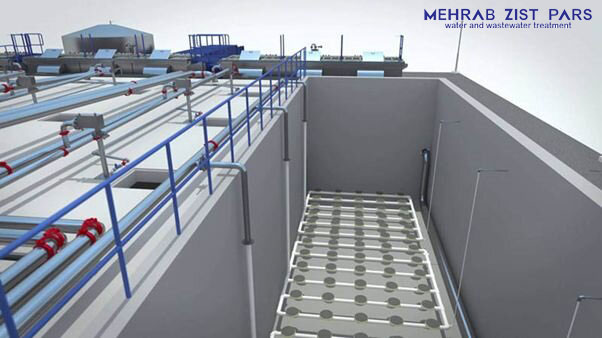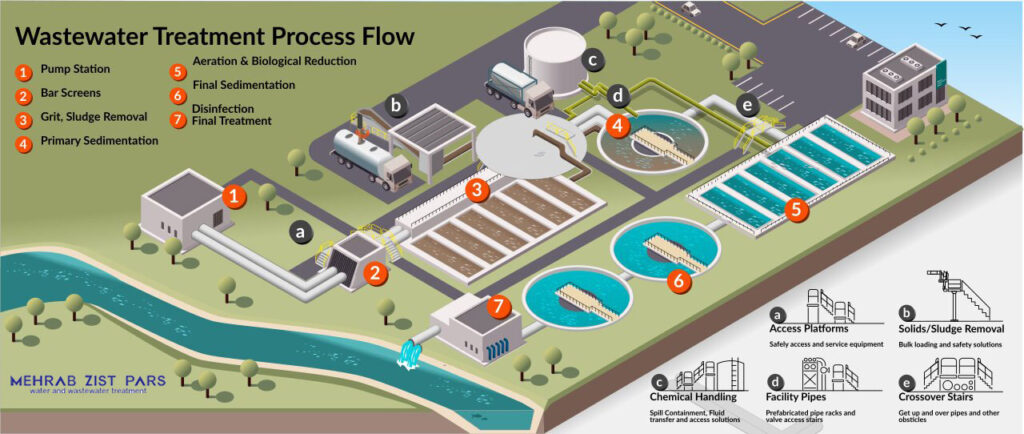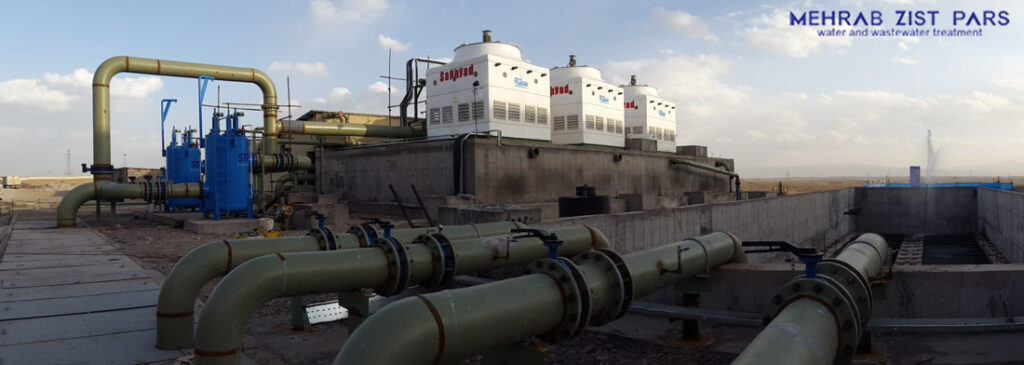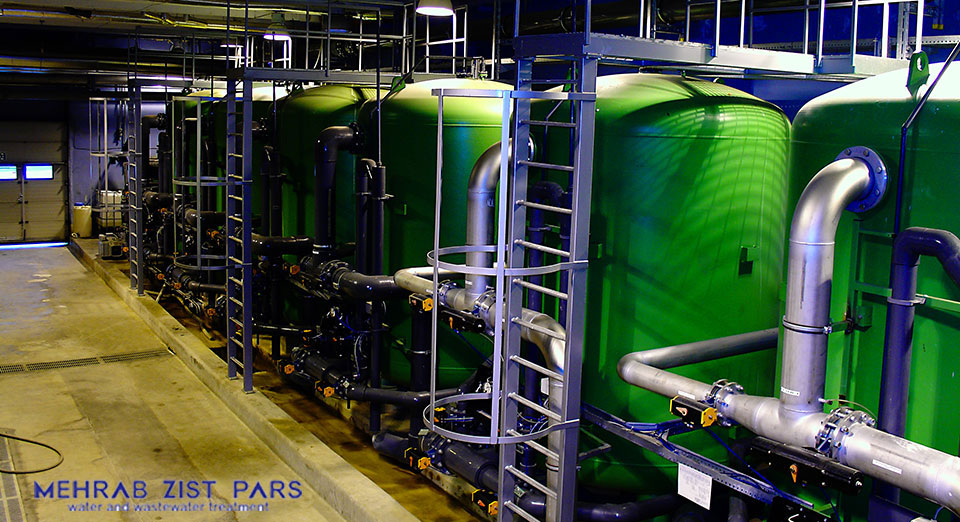The industrial wastewater treatment package is a set of equipment that is used for industrial wastewater treatment and is selected based on the type of pollutants found in industrial wastewater.
Industrial wastewater is one of the most important sources of environmental pollution and contains chemicals, heavy metals, organic substances and other harmful substances that can harm the environment and human health.
Industrial wastewater treatment is one of the important ways to reduce environmental pollution and preserve human health, and the industrial wastewater treatment package is also one of the most effective equipment for treating these wastewaters.
Join us in reading this article to discuss more about this.
What is the industrial wastewater treatment package?
Industrial wastewater treatment package is a set of equipment used for industrial wastewater treatment. These equipments are selected and designed based on the type of pollutants found in industrial wastewater.
The performance of the industrial wastewater treatment package includes the following steps:
Pre-treatment: In this step, suspended solids, fat and oil and other pollutants that can damage the treatment equipment are separated from the wastewater as much as possible.
Physical treatment: In this step, pollutants that can be easily separated are removed from the wastewater. Among the physical purification methods, we can mention coagulation and flocculation, filtration and ion exchange.
Chemical treatment: In this stage of the application of the industrial wastewater treatment package, pollutants that cannot be removed by physical methods are removed from the wastewater using chemicals. Among the chemical purification methods, we can mention chlorination, ozonation and advanced oxidation.
Biological treatment: In this step, pollutants that are capable of biological decomposition are removed from wastewater by microorganisms. Among the biological treatment methods, we can mention aeration, anaerobic treatment and wastewater treatment with activated sludge.
In some cases, industrial wastewater treatment processes may be combined. For example, in an industrial wastewater treatment package, physical and chemical treatment methods may be used simultaneously.
Application of industrial wastewater treatment package
Industrial wastewater is one of the most important sources of environmental pollution. A problem that has caused serious and sometimes irreversible damage to the environment in the last few decades.
These wastewaters contain chemicals, heavy metals, organic substances and other harmful and dangerous substances and can harm the environment and human health.
Fortunately, environmental researchers have also applied the necessary sensitivity in this field and have taken positive steps in this field by inventing special equipment to treat this type of wastewater.
Today, the use of industrial wastewater treatment is one of the important, useful and efficient ways to reduce environmental pollution and protect human health, which has been able to purify a large amount of these pollutions and prevent them from entering nature.
The industrial wastewater treatment package is used in a wide range of industries. Among the industries that use the industrial wastewater treatment package, the following can be mentioned:
Food and beverage industries: These industries produce wastewater containing organic substances, chemicals and heavy metals. Treatment of these wastewaters prevents harmful substances from entering the environment and drinking water.
Textile industries: These industries produce wastewater containing dyes, chemicals and detergents. Treatment of these wastewaters prevents the entry of harmful substances into underground and surface waters.
Petrochemical and oil and gas industries: These industries produce wastewater containing petroleum, chemicals and toxic substances, which will cause heavy damage to nature if they enter the environmental cycle. By treating these wastewaters with the industrial wastewater treatment package, harmful substances are prevented from entering the environment and underground water.
Metal industries: These industries produce wastewater containing heavy metals, chemicals and detergents. Treatment of these wastewaters prevents harmful substances from entering the environment and underground water.
Mineral industries: These industries produce wastewater containing minerals, chemicals and detergents and prevent harmful substances from entering the environment and underground water.
Advantages of industrial wastewater treatment device
Using the industrial wastewater treatment package has many advantages, the most important of which are the following:
Reducing environmental pollution: Industrial wastewater treatment prevents harmful substances from entering the environment and helps maintain the health of the environment. This case, considering the increasing population and increasing amount of waste water production on the one hand and the severity of environmental pollution in recent years, on the other hand, if purifiers are not used, it can lead to an environmental disaster. With the help of industrial wastewater treatment packages, these damages can be prevented to a large extent.
Preservation of human health: industrial wastewater treatment prevents the entry of harmful substances into drinking water and water resources and helps to preserve human health. In addition to the advantage of maintaining human health, this case also significantly reduces the costs associated with treatment, and for this reason, it will be associated with a high economic benefit for societies.
Reducing the cost of wastewater treatment: The industrial wastewater treatment package is less expensive than the traditional methods of wastewater treatment. In this way, by using these packages, it is possible to get access to clean and purified water by spending less money and save a lot in this case and also in water resources.
Increasing production efficiency: Industrial wastewater treatment increases production efficiency and, for example, in the food industry, it can increase the quality of food products. In other industries such as agriculture and production, the application of industrial wastewater treatment package plays an important role in increasing production efficiency and increasing work efficiency.
Industrial wastewater treatment method
The working method of the industrial wastewater treatment package is selected based on the needs of industrial units and according to the type of wastewater of these centers. In general, due to the heavy nature of this type of wastewater and the presence of harmful substances and dangerous pollutants in it, special industrial wastewater treatment packages with special features are prepared and used.
Industrial wastewater is transferred to the industrial wastewater treatment package through piping. In the pre-treatment stage, suspended solids, grease and oil and other pollutants that may stick to the treatment equipment and damage them are separated from the wastewater solution.
In the physical treatment stage, easily separable pollutants are removed from the wastewater. Among the physical purification methods, we can mention coagulation and flocculation, filtration and ion exchange.
In the chemical treatment stage, pollutants that cannot be removed by physical methods are removed from the wastewater using chemicals.
In the stage of biological treatment, pollutants that are capable of biological decomposition are removed from wastewater by microorganisms, and then the treated wastewater is discharged into the environment through piping.
Based on this, the industrial wastewater treatment package is an efficient tool for industrial wastewater treatment that, by using different treatment methods, is able to remove pollutants in industrial wastewater and turn it into water with a suitable quality for discharge into the environment.
Due to the water crisis, today the industrial wastewater treatment package is considered an important and vital item in supplying water needed for various uses and is very valuable.
Design of industrial wastewater treatment device
Designing an industrial wastewater treatment device is a complex process that must be done with care and attention, and several parameters must be taken into account in order to do it correctly and completely. After checking these parameters, you can choose the appropriate purification methods.
Industrial wastewater refers to wastewater that is produced from industrial, production and service units and contains dangerous pollutants that can cause serious and extensive damage to the environment and human health. For this reason, industrial wastewater treatment is one of the most important measures to reduce environmental pollution and preserve human health, and has received a lot of attention in recent years. Accordingly, the design of equipment related to this industry is very complex and must be completed and set up by expert users.
Industrial wastewater treatment methods
Industrial wastewater treatment methods are generally divided into two categories:
Physical methods: In physical methods, pollutants that can be easily separated are removed from wastewater. Among the physical methods of industrial wastewater treatment, the following can be mentioned:
Coagulation and flocculation: Coagulation and flocculation is a physical method for removing suspended solids, heavy metals and other pollutants from wastewater. In this method, certain chemicals are added to the wastewater that cause coagulation of pollutants. Coagulating materials are usually aluminum chloride, aluminum sulfate or polyelectrolytes.
After coagulation, pollutants are suspended in water in the form of small clots. These clots are then deposited in sedimentation tanks and separated from the wastewater.
Filtration: Filtration is a physical method for removing suspended solids, chemicals, and microorganisms from wastewater. In this method, the wastewater passes through a filter bed. The filter bed can be composed of different materials such as sand, gravel, activated carbon or ion exchange resins.
Suspended solids and other pollutants are trapped in the filter bed and separated from the wastewater. The treated wastewater is then discharged through the filter.
Chemical methods: In these methods, chemicals are used to break down and separate the materials in the wastewater. Among the chemical methods for industrial wastewater treatment are chlorination, ozonation, advanced oxidation and ion exchange.
Chlorination: In this method, wastewater enters a tank along with chlorine. Chlorine reacts with organic substances in wastewater and oxidizes them. This reaction causes the destruction of organic matter and the reduction of BOD and COD of wastewater. Also, chlorine disinfects wastewater and destroys harmful microorganisms.
Ozonation: Wastewater enters a tank with ozone. Ozone reacts with organic substances in wastewater and oxidizes them. This reaction causes the destruction of organic matter and the reduction of BOD and COD of wastewater. Also, ozone disinfects wastewater and destroys harmful microorganisms.
Advanced oxidation: Wastewater enters a tank with a strong oxidizing agent such as hydrogen peroxide, potassium permanganate or hydrogen peroxide. The oxidizing agent reacts with the organic substances in the wastewater and oxidizes them. This reaction causes the destruction of organic, mineral and micro-organisms in the wastewater.
Ion exchange: Ion exchange is a chemical method for removing harmful ions from wastewater. In this method, ion exchange resins are used. Ion exchange resins contain specific ions that can be exchanged with harmful ions in wastewater. For example, ion exchange resins containing sodium ions can exchange chloride, sulfate, and other harmful ions in wastewater.
Wastewater is purified from harmful ions after passing through ion exchange resins. Harmful ions that have been transferred to ion exchange resins can be removed from the resins using special chemicals.
The difference between coagulation and flocculation, filtration and ion exchange methods
Industrial wastewater treatment is one of the most important measures to reduce environmental pollution and protect human health. In industrial wastewater treatment, various methods are used to remove pollutants in wastewater.
Physical methods of wastewater treatment separate pollutants from wastewater based on their physical properties. These methods are relatively simple and cheap, but may not be enough to remove some pollutants in one step and require several steps to perform optimally.
In chemical methods, pollutants that cannot be removed by physical methods are removed from wastewater using chemicals.
In biological methods, pollutants that are capable of biological decomposition are removed from wastewater by microorganisms. Among the biological methods of industrial wastewater treatment, the following can be mentioned:
After choosing the purification methods, the equipment needed for each of the purification steps can be determined.
In this section, we will explain the difference between coagulation and flocculation, filtration and ion exchange methods.
Coagulation and clotting
Coagulation and flocculation is a physical method to remove suspended solids, heavy metals and other pollutants from wastewater. In this method, certain chemicals are added to the wastewater that cause coagulation of pollutants. Coagulants are usually aluminum chloride, aluminum sulfate, or polyelectrolytes.
Filtration
This is a physical method for removing suspended solids, chemicals and microorganisms from wastewater, during which the wastewater passes through a filter bed. The filter bed can be composed of different materials such as sand, gravel, activated carbon or ion exchange resins.
Suspended solids and other pollutants are trapped in the filter bed and separated from the wastewater, and then the treated wastewater is discharged from the filter.
Familiarity with industrial wastewater treatment equipment
There are different types of industrial wastewater treatment equipment, including the following:
Pre-treatment tanks: These tanks are designed and used to separate suspended solids, grease and oil and other pollutants that damage the treatment equipment.
Physical purification equipment including: filter plates, sedimentation tanks and ion exchange reactor
Chemical treatment equipment including: chlorination tanks, ozonation tanks and advanced oxidation tanks
Biological treatment equipment including: aeration tank, anaerobic tank and wastewater treatment tank with activated sludge
Finally, the budget estimation for buying equipment, building treatment ponds or buying prefabricated packages, accurate estimation of the number of manpower required in each of the departments and the estimation of the time required for the construction of the industrial wastewater treatment plant are done.
Important points in the design of industrial wastewater treatment device
Designing an industrial wastewater treatment device is a complex and multifaceted process that must be done with care and attention. In this process, several factors must be considered, among the most important of which the following can be mentioned:
The location of the treatment plant: This location should be suitable in terms of factors such as soil type, wind direction, temperature conditions, distance from the river level and underground water tables.
Amount of produced wastewater: This is one of the most important factors in the design of the industrial wastewater treatment device.
Chemical composition of wastewater: The chemical composition of wastewater includes pollutants that must be removed in different stages of treatment.
Desired quality level: This level determines what purification methods should be used.
Attention to environmental issues: environmental issues should also be considered in the design of the industrial wastewater treatment device. For example, materials and materials that have the least negative environmental effects should be used.
Attention to legal requirements: In the design of the industrial wastewater treatment device, the legal requirements related to industrial wastewater treatment in the target country must be observed. These requirements are usually set by competent government agencies, such as the Environment Agency. Some of the legal requirements related to industrial wastewater treatment are:
The degree of quality of wastewater after treatment: The quality of wastewater after treatment must be in accordance with the standards set by the environmental organization.
Used equipment and technologies: The use of new equipment and technologies can help improve the performance of the industrial wastewater treatment device and reduce treatment costs. These equipment and technologies used must be approved by the environmental organization. Some of the new industrial wastewater treatment technologies are:
1. Wastewater treatment using nanotechnology
2. Wastewater treatment using biological technology
3. Wastewater treatment using electrochemical technology
4. Attention to environmental issues
In the design of the industrial wastewater treatment device, environmental issues should also be considered. For example, materials that have the least environmental impact should be used. Treatment methods used: The treatment methods used in industrial wastewater treatment must be approved by the Environmental Organization.
Some of the environmental issues that must be considered in the design of the industrial wastewater treatment plant are:
1. Groundwater pollution
2. Soil pollution
3. Air pollution
4. Production of greenhouse gases
Observing important points in the design of industrial wastewater treatment devices can help improve the performance of these devices and reduce treatment costs and reduce the environmental effects of industrial wastewater treatment.
Buying an industrial wastewater treatment package
The industrial wastewater treatment package is an important part of the protection and environmental organization in every industrial complex, which must be done with the necessary precision and expertise. Considering the high price of this equipment, it is necessary to use important and key points in choosing these packages.
The price of the industrial and sanitary wastewater treatment package is variable and depends on various factors. To determine the exact price of these packages, you should consult with sewage treatment experts.
In this part of the article, we will discuss 2 important cases of these factors:
• Geographical location and weather conditions: the costs of making sanitary waste treatment packages are different in different regions, and the desired climate and weather conditions also affect the costs of making sanitary waste treatment packages.
• Access to materials and equipment: Access to materials and equipment needed to make sanitary waste treatment packages affects the costs of making these packages. In areas where access to this equipment is associated with lower costs, the prices will definitely be lower.
The price of the industrial wastewater treatment package
The price of the industrial wastewater treatment package depends on various factors, including the following:
Type of treatment process: Industrial wastewater treatment processes are divided into two main categories: physical, chemical and biological, each of which has its own costs.
The amount of produced wastewater: the higher the amount of produced wastewater, the higher the treatment costs.
Quality of incoming wastewater: The quality of incoming wastewater affects the type of treatment process and its costs. The heavier the amount of imported industrial waste water and the higher its pollution level, the higher the price of the desired industrial waste water treatment package.
The quality of treated wastewater: this factor depends on the amount of pollutants in it. The higher the quality of treated wastewater, that is, the lower the amount of pollutants in it, the higher the treatment costs. The reason is that more complex and expensive purification processes are used to remove more pollutants.
For example, biological treatment processes are used to treat wastewater that contains large amounts of pollutants. These processes have more time and cost than physical and chemical purification processes.
Therefore, in order to reduce the costs of industrial wastewater treatment, efforts should be made to increase the quality of wastewater entering the treatment package as much as possible. This can be done by taking steps such as separating solids and oil from the wastewater before it enters the treatment package.
Used equipment: The price of the equipment used in the industrial wastewater treatment package, including pipes, tanks and other equipment, affects the treatment costs.
Types of industrial wastewater treatment packages in terms of gender
Types of industrial wastewater treatment packages are divided into two general categories in terms of gender:
Metal industrial wastewater treatment packages: these products are made of steel, steel or aluminum and are usually used for high capacities. These purification packages have high strength and durability and can withstand different environmental conditions, such as temperature, humidity and pressure.
Among the advantages of the metallic industrial wastewater treatment package, the following can be mentioned:
• High strength and durability
• Resistance to different environmental conditions
Can be used in high capacities
Disadvantages of this type of industrial wastewater treatment package are high weight, need for periodic maintenance and higher price than polymer packages.
Polymer industrial wastewater treatment packages: These products are made of polyethylene, polypropylene or other polymers and are often used for low to medium capacities.
The polymer industrial wastewater treatment package is light in weight and easy to install and operate. In addition, they have a lower price than metal packages.
Among the advantages of the polymer industrial wastewater treatment package, the following can be mentioned:
• Light weight
• Easy installation and setup
• Low price
Their disadvantages are less resistance to different environmental conditions and limited ability to use in low to medium capacities.
Choosing the type of industrial wastewater treatment package should be done according to various factors such as treatment capacity, environmental conditions and budget.
Treatment steps in the industrial wastewater treatment device
The stages of wastewater treatment in an industrial wastewater treatment device are generally divided into three main stages:
Pre-treatment stage
In this step, suspended solids, grease and oil and other pollutants that can damage the treatment equipment are separated from the wastewater, which includes the following steps:
Debrising: In this step, large solids, such as plastic, paper, and other solids, are separated from the wastewater.
Sedimentation: In this step, finer suspended solids, such as gravel, sand and other solids, are separated from the wastewater.
Fat and oil separation: In this step, fat and oil are separated from the wastewater.
The main purification step
In the main treatment stage, pollutants that are capable of biological decomposition are removed from wastewater by microorganisms and include the following steps:
Aeration: In this step, oxygen is added to the wastewater so that microorganisms can break down the pollutants.
Wastewater treatment with activated sludge: In this step, microorganisms break down pollutants in a tank called an activated sludge bed.
Post-treatment stage
In this section, the pollutants that were not removed in the previous steps are separated from the wastewater. This step includes the following steps:
Filtration: In this step, suspended solids, chemicals and microorganisms are separated from the wastewater.
Chemical treatment: In this step, pollutants that are not capable of biological decomposition are removed from the wastewater using chemicals.
Chlorination: In this step, chlorine is added to the wastewater to kill the remaining microorganisms.
conclusion
The industrial wastewater treatment package is considered an effective solution to reduce environmental pollution and preserve the health of humans and other living creatures in nature. This equipment removes pollutants in industrial wastewater using different methods.
Choosing the type of industrial wastewater treatment package should be done according to various factors such as the type of pollutants in the wastewater, the amount of produced wastewater and the quality of the treated wastewater, as well as the price of these products and the desired budget.
These types of wastewater treatment packages have advantages such as reducing environmental pollution, preserving human health, saving water consumption, and reducing wastewater disposal costs, although they also have side costs.
Nowadays, due to the expansion of various industries and the increase in the level of pollution caused by their wastewater, the use of industrial wastewater treatment packages is essential in various industries.
In the end, it should be mentioned that industrial wastewater treatment is a complex process that requires sufficient knowledge and experience, and for the optimal selection and design of the industrial wastewater treatment package, you can consult the experts of Mehrab Zit Pars Company.







 العربية
العربية فارسی
فارسی